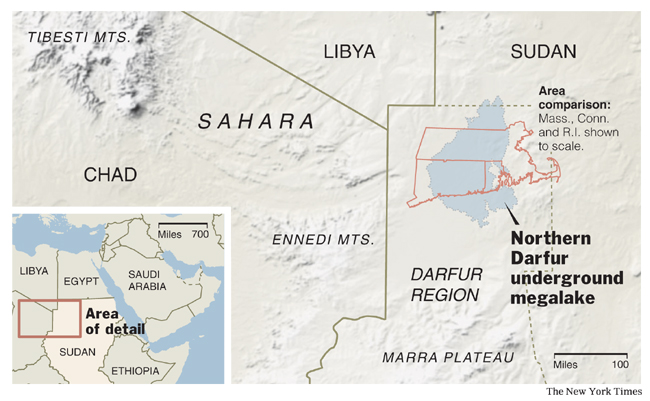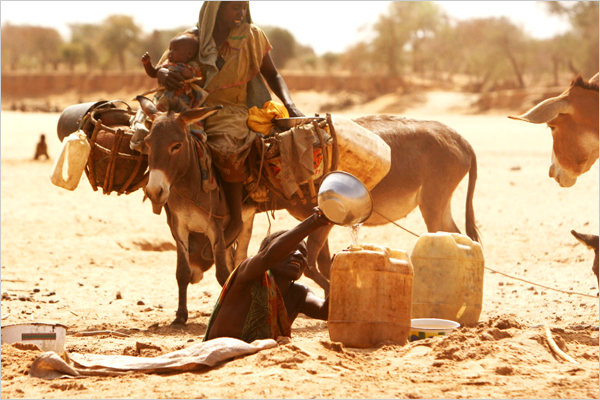Ilankai Tamil Sangam
Association of Tamils of Sri Lanka in the USA
Published by Sangam.org
A Godsend for Darfur, or a Curse?
by Lydia Polgreen, The New York Times, July 22, 2007
|
Post-colonial governments, which in the early years had the blessing of the World Bank and the International Monetary Fund, took vast tracts of land in the name of agricultural development, turning farmers who worked their own land into wage laborers for the state and its allies.
Some Sudanese have even been pushed off their land entirely. In the early 1990s the Nuba people were forced into “peace villages,” where they provided a steady supply of cheap, captive labor to mechanized farms. In other areas, including parts of Darfur, intensive mechanized farming by the government and investors who were heedless to the need to protect the fertility of the land left large tracts barren.
A vast new agricultural scheme in a largely uninhabited swath of northern Darfur is more likely to fit into this destructive pattern than not...
“The predominant root of conflict in Sudan is the instability that results from the systemic abuse of the rural (and recently urbanized) poor at the hands of the economic and political elites of central Sudan.” |
The announcement by researchers at Boston University last week that a vast underground lake the size of Lake Erie had been discovered beneath the barren soil of northern Darfur, a blood-soaked but otherwise parched land racked by war for the past four years, was greeted by rapturous hopes. Could this, at last, bring deliverance from a cataclysmic conflict that has killed at least 200,000 people and pushed more than 2.5 million from their homes?
 That hope is built upon an argument, advanced by a United Nations report released last month and an opinion article in The Washington Post by Ban Ki-Moon, the United Nations secretary general, that environmental degradation and the symptoms of a warming planet are at the root of the Darfur crisis.
That hope is built upon an argument, advanced by a United Nations report released last month and an opinion article in The Washington Post by Ban Ki-Moon, the United Nations secretary general, that environmental degradation and the symptoms of a warming planet are at the root of the Darfur crisis.
“There is a very strong link between land degradation, desertification and conflict in Darfur,” said the United Nations Environmental Program report, which noted that rainfall in northern Darfur has decreased by a third over the last 80 years. “Exponential population growth and related environmental stress have created the conditions for conflicts to be triggered and sustained by political, tribal or ethnic differences,” the report said, adding that Darfur “can be considered a tragic example of the social breakdown that can result from ecological collapse.”
The idea that more water — unearthed through a thousand wells sunk into the underground lake — could neatly defuse the crisis is seductive. Messy African conflicts, from Congo to Liberia, from northern Uganda to Angola, have a way of defying all efforts to solve them. Instead, they seem to become hopelessly more complex as they drag on, year after agonizing year. A scientific explanation for the problem (environmental degradation) along with a tidy technological solution (irrigation) gratifies the modern humanitarian impulse.
But the history of Sudan, a grim chronicle of civil war, famine, coups and despotism, gives ample reason to be skeptical.
“Like all resources water can be used for good or ill,” said Alex de Waal, a scholar who has studied the impact of climate variation in Sudan and who witnessed the 1984-85 famine that is often cited as the beginning of the ecological crisis gripping Darfur. “It can be a blessing or also a curse. If the government acts true to form and tries to create some sort of oasis in the desert and control who settles there, that would simply be an extension of the crisis, not a solution.”
The droughts that gripped Sudan in the 1980s, and the migrations and other social changes they forced, have doubtless played a role in the conflict by increasing competition for water and land between farmers, who tend to be non-Arab, and herders, many of whom are Arabs. But an environmental catastrophe cannot become a violent cataclysm without a powerful human hand to guide it in that direction.
“These wider environmental factors don’t have impact in and of themselves” in terms of fomenting conflict, Mr. de Waal said. “The question is how they are managed.”
In fact, while different regions and social groups suffer severely, Sudan as a whole has riches to spare, in oil, fertile soil, and even water. Indeed, history suggests that this newly discovered lake is just as likely to become a source of conflict as a solution to the bloodshed.
 Successive Sudanese governments and their colonial precursors have adopted agricultural policies that have almost inevitably led to conflict. They have favored large mechanized farms and complex irrigation schemes, controlled by the government and its allies, over the small, rain-fed farms that are the backbone of the rural economy in much of Sudan.
Successive Sudanese governments and their colonial precursors have adopted agricultural policies that have almost inevitably led to conflict. They have favored large mechanized farms and complex irrigation schemes, controlled by the government and its allies, over the small, rain-fed farms that are the backbone of the rural economy in much of Sudan.
In eastern Sudan, where a rebellion has been brewing for years, the Beja people have nursed grievances since Britain and Egypt ruled Sudan jointly during the first half of the 20th century. Under their rule, irrigation programs for commercial farming deprived the Beja of their prime grazing land.
Post-colonial governments, which in the early years had the blessing of the World Bank and the International Monetary Fund, took vast tracts of land in the name of agricultural development, turning farmers who worked their own land into wage laborers for the state and its allies.
Some Sudanese have even been pushed off their land entirely. In the early 1990s the Nuba people were forced into “peace villages,” where they provided a steady supply of cheap, captive labor to mechanized farms. In other areas, including parts of Darfur, intensive mechanized farming by the government and investors who were heedless to the need to protect the fertility of the land left large tracts barren.
A vast new agricultural scheme in a largely uninhabited swath of northern Darfur is more likely to fit into this destructive pattern than not, said John Prendergast, a founder of the Enough Project, an initiative of the Center for American Progress and the International Crisis Group to abolish genocide and mass atrocities.
“Climate change and the lack of rain are much less important than the land-use patterns promoted by the government of Sudan and the development policies of World Bank and I.M.F., which were focused on intensive agricultural expansion that really mined the soils and left a lot of land unusable,” said Mr. Prendergast, who has been studying Sudan for 20 years. “That was probably the principal impetus for a lot of intra-Darfur migration in the decades leading up to the conflict in Darfur.”
During those years, the government exploited tensions over water and land to achieve its own aims, putting down a rebellion among the non-Arab tribes, who rose up because they wanted a greater share of Sudan’s wealth and power. It armed tribal militias to fight the rebels, and these militias unleashed a tide of violence that ultimately would become, according to the Bush administration and many others, the 21st century’s first genocide.
A report released last year by the Coalition for International Justice on the role that oil and mechanized farming have played in human rights abuses in Sudan concluded: “The predominant root of conflict in Sudan is the instability that results from the systemic abuse of the rural (and recently urbanized) poor at the hands of the economic and political elites of central Sudan.”
In this analysis, the heart of the Darfur conflict, as in all conflicts in Sudan, is the battle for control of resources and riches, but not between farmers and herders, northerners and southerners, Christians and Muslims, or Arabs and non-Arabs.
It is a conflict between those at the center of the country, the elites who have controlled Sudan and its wealth for the past century and a half, and the desperately poor people who beg for scraps from the periphery.
Until that equation changes, many analysts argue, nothing else will.
© 1996-2025 Ilankai Tamil Sangam, USA, Inc.
 That hope is built upon an argument, advanced by a United Nations report released last month and an opinion article in The Washington Post by Ban Ki-Moon, the United Nations secretary general, that environmental degradation and the symptoms of a warming planet are at the root of the Darfur crisis.
That hope is built upon an argument, advanced by a United Nations report released last month and an opinion article in The Washington Post by Ban Ki-Moon, the United Nations secretary general, that environmental degradation and the symptoms of a warming planet are at the root of the Darfur crisis.  Successive Sudanese governments and their colonial precursors have adopted agricultural policies that have almost inevitably led to conflict. They have favored large mechanized farms and complex irrigation schemes, controlled by the government and its allies, over the small, rain-fed farms that are the backbone of the rural economy in much of Sudan.
Successive Sudanese governments and their colonial precursors have adopted agricultural policies that have almost inevitably led to conflict. They have favored large mechanized farms and complex irrigation schemes, controlled by the government and its allies, over the small, rain-fed farms that are the backbone of the rural economy in much of Sudan.